Content
It is recommended to feed the hosts in spring 2 times - after the plant wakes up and at the end of May. In both cases, nitrogen and organic fertilizers are given. The next stage is the application of fertilizers in the summer at the stage of budding and flowering. The last time it is recommended to give top dressing no later than early September.
Host feeding goals
Almost all plants need feeding, and the purpose of fertilization depends on the season:
- In the spring, the bushes are given nitrogen and organic fertilizers in order to bring them out of hibernation and ensure rapid growth after the winter period.
- In summer, feeding is given at the budding stage to get a lush flowering bush.
- Top dressing of the host with fertilizers in the fall is carried out to prepare for winter, so that the plant can withstand the cold. This is especially important for regions with extreme frosts - the Urals, Siberia and the Far East.
Fertilizers are also applied to increase resistance to diseases and pests. Enhanced nutrition is relied upon in the presence of symptoms of damage, as well as after transplanting the plant to a new place.
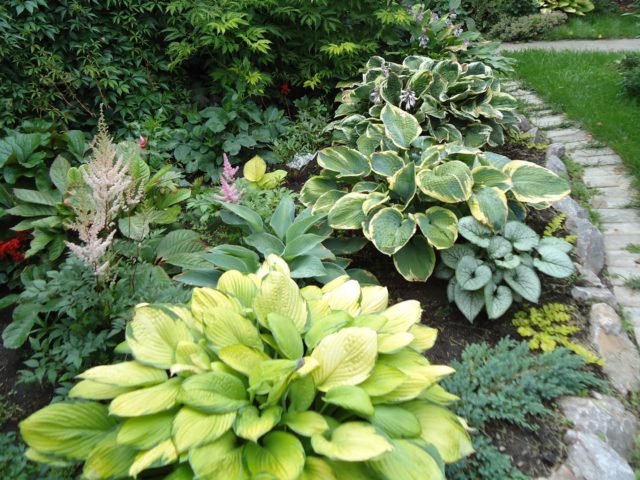
Top dressing provides not only fast growth, but also resistance to disease
Signs of a nutrient deficiency
If you do not fertilize when planting hosts and subsequently, the plant will gradually show signs of a lack of substances. This will affect the condition of the leaves and the general decorativeness. Then resistance to frost, pests and diseases may decrease. Therefore, it is useful to know by what signs you can determine the lack of fertilizers, and then apply the appropriate top dressing.
For example, if there is a lack of nitrogen:
- bushes grow poorly;
- veins turn yellow or turn white on the leaves;
- shoots and leaves become weak even with regular watering.
In case of insufficient potassium dressing, the following symptoms appear:
- spots of different colors on the leaves;
- leaves wither and curl;
- begin to fall;
- the bush looks weak.
The deficiency of phosphorus supplements can be determined by the following criteria:
- apical shoots become lethargic;
- leaves take on darker shades;
- growth is declining markedly.
With a lack of calcium:
- leaves curl;
- they darken and may acquire unusual bluish tints.
Fertilizers for hosts
Organic fertilizers are often used to feed the host. They provide the plant with the necessary substances, stimulate the vital activity of soil bacteria and beneficial insects. Usually hosts are given the following organic matter:
- compost;
- rotted bark;
- hay;
- straw;
- husk from nuts and seeds;
- rotted manure;
- bone meal.
Despite the fact that organic matter is the main "diet" of this plant, hosts also need mineral supplements:
- potassium sulfate;
- superphosphates;
- potassium magnesium;
- wood ash;
- special mixtures for the host (can be purchased at the country store);
- green fertilizers (siderates) - for example, crushed wild mustard, which saturates the soil with nitrogen compounds.
They can be used in liquid form, diluting the solution according to the instructions, or given long-acting granules.Gardeners often use drugs such as Osmokot and Bazakot.
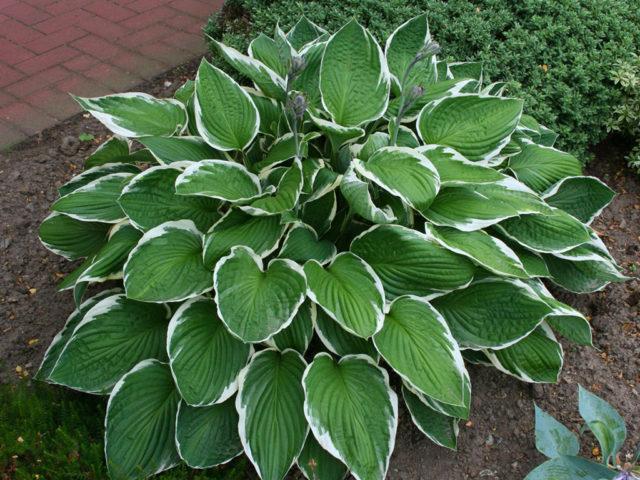
When determining the dosage, you need to be guided by the instructions
Some types of dressings that are used for other plants are categorically contraindicated for hosts. This is ammonium nitrate, which promotes too rapid growth, fresh manure, chicken droppings and urea. It is also undesirable to use mixtures of inorganic fertilizers that contain nitrogen compounds.
When to feed hosts
It is recommended to feed the host regularly, 3-5 times per season:
- When planting (March - April), the plant is given organic matter in the form of humus. It is brought into the hole or scattered over the surface.
- After the plant wakes up for the next season (early April), humus or complex mineral fertilizer is applied as top dressing. It allows hosts to grow steadily. Also, complex fertilizer can be given at the end of May. This is especially important if the previous step was skipped.
- Summer dressing is applied at the stage of bud formation. It ensures long-lasting flowering and protects the plant from pests.
- In summer, organic fertilizing is also given in the form of a layer of mulch to prepare the bush for winter: in terms of approximately late July - early August.
- In the fall, hosta can be fertilized with ash, which is obtained after burning the branches. The infusion is prepared on the basis of a dosage of 300 g of ash per 10 liters of water. You can let it sit for a few days, and then stir and water the soil, being careful not to get on the leaves.
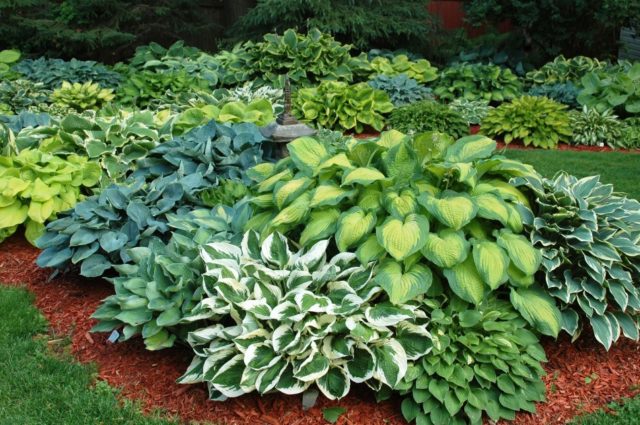
Fertilizers are applied more often in spring and summer.
How to fertilize hosts when planting
Every plant needs feeding when planting, and the hosta is no exception. After preparing the planting pit, humus and compost should be poured into it in equal quantities. Then the seedling is rooted, sprinkled with earth, compacted a little and watered abundantly.
If hosta food was not applied at the time of planting, it can simply be sprinkled on the surface. For better assimilation, the soil is also watered abundantly. Then it can be mulched with straw, hay or pine needles for better moisture retention.
How to feed the host for growth
Experienced gardeners recommend feeding the hosta in the spring for lush growth - this is of great importance for both young bushes and adult plants. To do this, you can add (1 top dressing of your choice):
- fresh humus;
- complex mineral fertilizer.
The optimal time is right after the plant wakes up, when the buds begin to open (early April). If this stage has been skipped, then complex fertilizer is given in late spring or early summer.
How to feed hosts in summer
In summer, fertilizers are applied at the stage of bud formation so that the bush can get stronger and grow green mass. For this, nitrogen or complex fertilizers are given in early June. They are preliminarily dissolved and thoroughly watered the soil, without getting on the foliage and buds.
In the summer (at the beginning of August), you can also feed the hosta to prepare for the winter: for this, superphosphates and potassium sulfate are given. These dressings promote greater accumulation of nutrients in the rhizomes. Therefore, the plant will survive the cold period much better.
How to fertilize hosts for lush flowering
Since buds begin to form on the bush in early summer, it is important to add additional feed for a lush bloom. These are compounds of phosphorus and potassium:
- calcium phosphate;
- phosphate rock and bone meal;
- ammophos;
- superphosphate - regular and double;
- potassium sulfate;
- potassium chloride;
- potassium magnesium.
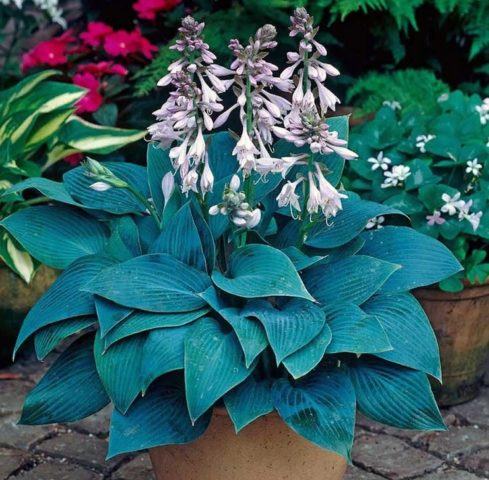
You can make these dressings 1-2 times at the stage of bud formation and when the first flowers appear.
How to feed the host in the fall
Autumn feeding of hosts to prepare for winter can be carried out both at the beginning of September and at the end of summer (mid-August). At this point, the bush must be prepared for the cold weather. You can use special mixtures, for example:
- Fertika Autumn;
- Bonna Forte Autumn;
- "Ogorodnik Autumn".
You can also feed the hosta with wood ash in front of the shelter in the fall. It will provide the plant with a calm winter. It is not necessary to apply other fertilizers, so as not to create conditions for the active growth of new shoots.
How to feed hosts properly
Top dressing is applied in liquid or dry form. In the first case, the mixture is preliminarily dissolved in a standard 10 liter bucket of water, choosing the dosage according to the instructions. It is better to water the hosta at the end of the day, at sunset, or in the morning (until 10-11 o'clock). In this case, you need to try not to fall on the leaves, watering only the soil.
In the second case, the mixture or granules are simply scattered over the soil surface, in the diameter of the trunk circle. The nutrients must first be absorbed by the roots, and only then they will enter the stems and leaves of the hosta.
You can feed the hosts with fertilizers in the fall and in other seasons in 2 ways:
- Root - pour over with liquid solution or scatter granules over the soil. In this case, it is important that even dry dressing does not fall on the leaves.
- Foliar - for example, such top dressing as "Aquarin", "Solution", "Agrovit Aqua" is used. Solutions are prepared according to the instructions, after which they are poured into a spray bottle and fully processed.
The dosage is selected according to the instructions. It is also worth paying attention to generally accepted standards.
Fertilizer | Dosage for 1 adult bush |
Potash | 20 g |
Phosphoric | 15-20 g |
Wood ash | 300 g |
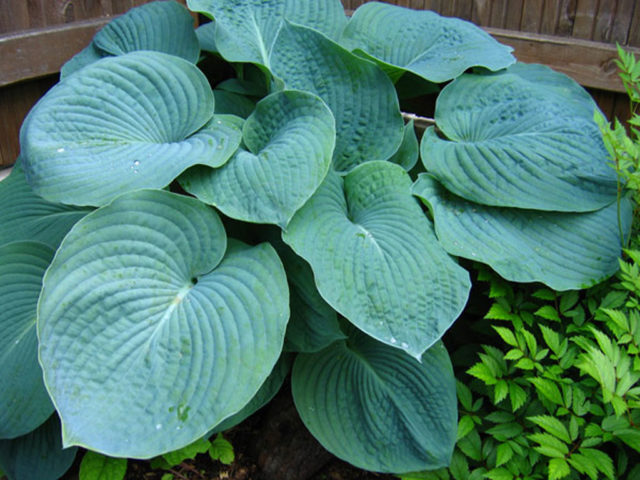
Plants with blue and blue leaves should not be foliarized: top dressing can destroy the protective wax coating
Conclusion
It is important to feed the hosts in spring, summer and fall. The most important is spring and summer feeding - with nitrogen and a mixture of superphosphates with potassium salt. For the winter, special fertilization is not required - you can simply pour it with an infusion of wood ash and mulch the roots.








